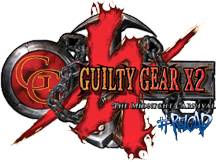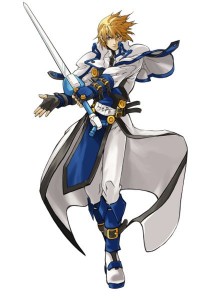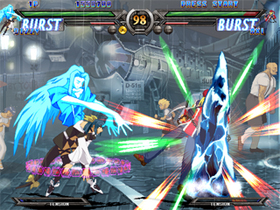G is for Guilty Gear
by Sindra, filed in Games, Powet Alphabet on Aug.15, 2009
Since the alphabet is the building block of our language, the Powet Alphabet is the building block of what makes us geeks.
 The Guilty Gear series is a string of fast-paced fighting games first developed by Japanese company Sammy in 1998. During an age where Mortal Kombat and Street Fighter was still champions of the fighting games, with Killer Instinct on its way out and Soul Caliber and Super Smash Bros. on their way in, it was a hard time to be a thrown into the fray, so to speak. However, if there was one thing that Guilty Gear games could always capitalize on, it was speed. Probably the fastest fighting game to date, the sheer velocity of the game made it a favorite amongst button mashers.
The Guilty Gear series is a string of fast-paced fighting games first developed by Japanese company Sammy in 1998. During an age where Mortal Kombat and Street Fighter was still champions of the fighting games, with Killer Instinct on its way out and Soul Caliber and Super Smash Bros. on their way in, it was a hard time to be a thrown into the fray, so to speak. However, if there was one thing that Guilty Gear games could always capitalize on, it was speed. Probably the fastest fighting game to date, the sheer velocity of the game made it a favorite amongst button mashers.
Not much of a story is attached to the game, which goes out of its way sometime to explain the more unusual characters it utilizes. Set a couple hundred years in the future, Guilty Gear begins as a tournament being held by a mysterious individual named Testament. A few years prior, a great war broke out between humanity and  creatures called Gears – who were human-made but ran amok. The strongest Gear was called Justice, who controlled most other Gears. Once Justice was sealed away, the other Gears lost their focus and were easily disposed of. Testament is secretly a remnant Gear who wishes to use the energy produced by the fighters in the tournament to punch a hole through the seal that binds Justice in another dimension. Thus, you have a dozen fighters to choose from to battle your way through the tournament to fight Testament, and ultimately Justice.
creatures called Gears – who were human-made but ran amok. The strongest Gear was called Justice, who controlled most other Gears. Once Justice was sealed away, the other Gears lost their focus and were easily disposed of. Testament is secretly a remnant Gear who wishes to use the energy produced by the fighters in the tournament to punch a hole through the seal that binds Justice in another dimension. Thus, you have a dozen fighters to choose from to battle your way through the tournament to fight Testament, and ultimately Justice.
Guilty Gear, originally for the Playstation, utilizes a lot of the standard fighting techniques used by other fighting games with the usual standard attacks. Combinations of button presses and directional circling, fighters can execute various special attacks, if their power gauge is high enough. It also introduced the concept of the Instant Kill – a button formula that when executed correctly, can try to catch the opponent within its range of birth, and promptly eliminate the character’s health entirely – that can be utilized at any point in the round. However this requires entering an “IK Mode” which drains your fighter’s health until the IK is either performed correctly, you leave IK mode, or you die. It’s basically a Fatality that you can perform at your leisure at any point, but with the catch of reducing your life and leaving you vulnerable.
 While the original Guilty Gear was more of an underground success, its sequels – Guilty Gear X and Guilty Gear XX – proved to be more popular. Guilty Gear X introduced a few new characters and a lot more executable moves, including counters and anti-air attacks. It also furthered the supposed plot of the game – with Justice having been defeated 3 years earlier, peace began to settle in the world again, until word of another controller-type Gear emerged – which prompted a worldwide bounty issued for the defeat of the mystery Gear, who turns out to actually be a half-Gear girl named Dizzy. Guilty Gear XX is an add-on to X rather than a sequel, and adds a few more characters and even more complex combat structure. The same could be said for Isuka and Accent Core – additional add-on titles. In fact, if there’s one thing that Guilty Gear has working against it, it’s the fact it hasn’t had a real sequel since X, and simply has been a rehashing of the same game (XX). A title called Guilty Gear: Overture was supposed to be a true sequel to the series, but fell incredibly short in terms of gameplay, controls, and overall feel that made the series popular and thus has been largely ignored by fans of the series and disregarded as the true “Guilty Gear 2”.
While the original Guilty Gear was more of an underground success, its sequels – Guilty Gear X and Guilty Gear XX – proved to be more popular. Guilty Gear X introduced a few new characters and a lot more executable moves, including counters and anti-air attacks. It also furthered the supposed plot of the game – with Justice having been defeated 3 years earlier, peace began to settle in the world again, until word of another controller-type Gear emerged – which prompted a worldwide bounty issued for the defeat of the mystery Gear, who turns out to actually be a half-Gear girl named Dizzy. Guilty Gear XX is an add-on to X rather than a sequel, and adds a few more characters and even more complex combat structure. The same could be said for Isuka and Accent Core – additional add-on titles. In fact, if there’s one thing that Guilty Gear has working against it, it’s the fact it hasn’t had a real sequel since X, and simply has been a rehashing of the same game (XX). A title called Guilty Gear: Overture was supposed to be a true sequel to the series, but fell incredibly short in terms of gameplay, controls, and overall feel that made the series popular and thus has been largely ignored by fans of the series and disregarded as the true “Guilty Gear 2”.
![]() Beyond the incredible pace of the game, as well as the ease of being able to pick it up quickly, the other shining point of the series has always been the music. Daisuke Ishawatari, who is also the voice for series anti-hero Sol BadGuy, composed the soundtrack to every game thus far, and has outdone himself each time with progressively harder, faster and overall kickass tracks. The speed of the game is perfectly accented by the speed of the music, as blaringly complex heavy-metal guitar riffs blaze through almost every tune. Indeed, the game bleeds rock music, right down to the character names which are either direct rips or anagrams of 80’s and 90’s metal bands or singers.
Beyond the incredible pace of the game, as well as the ease of being able to pick it up quickly, the other shining point of the series has always been the music. Daisuke Ishawatari, who is also the voice for series anti-hero Sol BadGuy, composed the soundtrack to every game thus far, and has outdone himself each time with progressively harder, faster and overall kickass tracks. The speed of the game is perfectly accented by the speed of the music, as blaringly complex heavy-metal guitar riffs blaze through almost every tune. Indeed, the game bleeds rock music, right down to the character names which are either direct rips or anagrams of 80’s and 90’s metal bands or singers.
In an age where 3D has become the mainstay, the Guilty Gear series has maintained its purity by sticking with beautifully rendered 2D animation and sprites since the very first game, and will hopefully continue to do so.


 PS3
PS3
 Famicom Dojo
Famicom Dojo KEEP PLAYING
KEEP PLAYING KEEP PLAYING: Rewind
KEEP PLAYING: Rewind Powet Toys
Powet Toys Powetcast
Powetcast Hitchhiker's Guide POWETcast
Hitchhiker's Guide POWETcast














